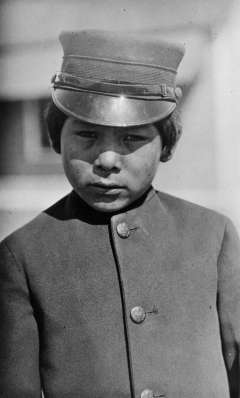Indian Boarding Schools, Wind River and the Pope

News this week of the pope’s visit to Canada caught us off guard. We hadn’t known he was coming. When he spoke, he offered an apology the size of a continent: “I humbly beg forgiveness for the evil committed by so many Christians against the Indigenous peoples,” he said, speaking in Spanish through an interpreter. “I ask forgiveness, in particular, for the ways in which many members of the church and of religious communities cooperated, not least through their indifference, in projects of cultural destruction and forced assimilation promoted by the governments of that time, which culminated in the system of residential schools.” Applause and shouts of approval from a largely Native audience greeted his remarks, the New York Times reported.
Beginning in the late 19th and running through most of the 20th century, the Canadian government subsidized Indian boarding schools. Nearly all were run by religious denominations, about 70 percent of them by Roman Catholics and the rest by Protestants. The former Ermineskin Residential Indian School, now demolished, was one of the largest and was run by Catholics on Cree land south of Edmonton, Alberta. There, last Monday in a powwow ring, the pope offered his apology.
His visit came about after a group of Indigenous Canadian leaders visited the Vatican earlier this spring. The pope apologized to them then and said he would come to Canada soon. But roots of the visit go back to generations of abuse and cultural deprivation of Indian children. In the early 2000s, a group of former students brought a class action suit against the Canadian government. A settlement in 2006 has generated payouts of 3.2 billion Canadian dollars to about 28,000 survivors. A National Truth and Reconciliation Commission report detailed the schools’ main purposes—to exterminate Indian languages and culture in order to “assimilate” the children into white society. Over more than 100 years, 150,000 children attended 130 schools, sometimes suffering violence, including sexual violence, and often hunger. The report called it “cultural genocide.”
From the 1880s through the early 1970s, schools on Wyoming’s Wind River Reservation also were run by church institutions. Father John Roberts founded an Episcopal mission and school at Fort Washakie, on the Eastern Shoshone end of the reservation, in 1883. The Jesuits opened St. Stephens Indian School a few years later at Ethete on the Arapaho end; students boarded there until 1939. The federal government, meanwhile, also opened a boarding school near Fort Washakie in 1892. It lasted into the 1950s and was known locally as “Gravy High” after a principal menu item. Elders today recall being beaten for speaking Arapaho or Shoshone at school; other people tell stories of being beaten at home for the same offense—to protect them from being beaten at school.
At the turn of the last century, it was fashionable to speak of Native people in the Americas as a “vanishing race” — a term that deftly mixed racism, nostalgia and remorse. Out of some combination of these, Philadelphia department-store heir Rodman Wanamaker and photographer Joseph Dixon hatched the idea of a statue of a Sioux man in New York harbor higher than the Statue of Liberty, as a memorial to what they saw as the vanishing race. The statue never happened. But Dixon subsequently toured and photographed 89 Indian reservations—including Wyoming’s—leaving a valuable record.
In October 1913 he spent two days on Wind River and made some compelling portraits of Arapaho and Shoshone people in traditional regalia. But one of the photos shows an unnamed Indian boy, 10 or 12 years old, in his school uniform—looking distrustful and weary. The boarding school idea, the assimilation idea, the “vanishing race” idea were at the peak of their powers. Indian people, thanks to their strong traditions, survived them. Let’s hope that boy survived, too. As to what the pope’s apology means, or whether it should be accepted, we can’t say. If only we could ask that boy.
Read
